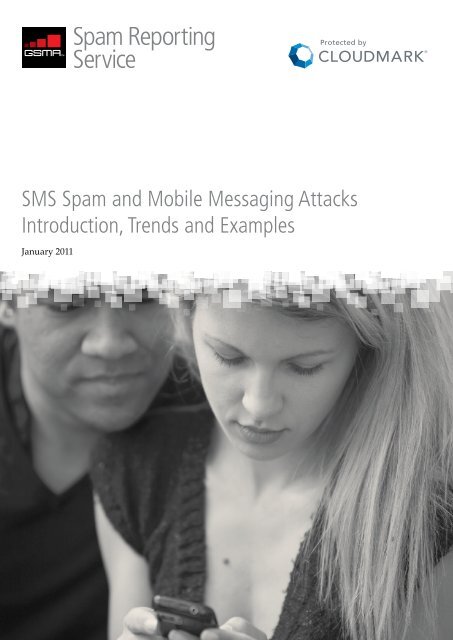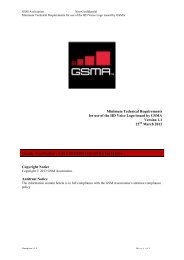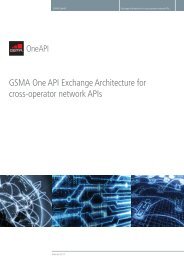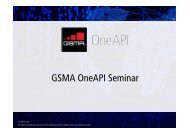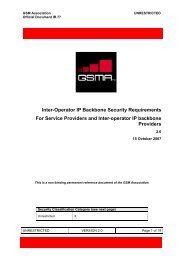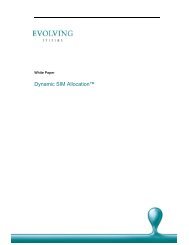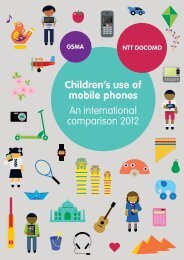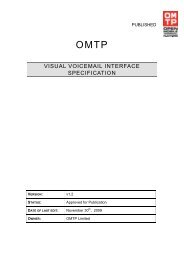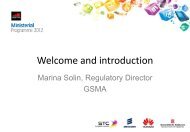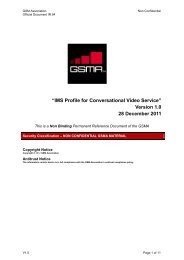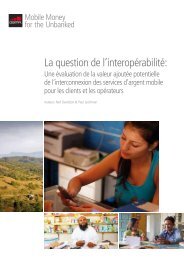SMS Spam and Mobile Messaging Attacks Introduction ... - GSMA
SMS Spam and Mobile Messaging Attacks Introduction ... - GSMA
SMS Spam and Mobile Messaging Attacks Introduction ... - GSMA
Create successful ePaper yourself
Turn your PDF publications into a flip-book with our unique Google optimized e-Paper software.
<strong>SMS</strong> <strong>Spam</strong> <strong>and</strong> <strong>Mobile</strong> <strong>Messaging</strong> <strong>Attacks</strong><br />
<strong>Introduction</strong>, Trends <strong>and</strong> Examples<br />
January 2011
<strong>GSMA</strong> <strong>Spam</strong> Reporting Service<br />
<strong>SMS</strong> <strong>Spam</strong> <strong>and</strong> <strong>Mobile</strong> <strong>Messaging</strong> <strong>Attacks</strong> - <strong>Introduction</strong>, Trends <strong>and</strong> Examples<br />
January 2011<br />
Contents<br />
1 <strong>Introduction</strong> 4<br />
2 Market trends resulting in an increase of <strong>SMS</strong> attacks 6<br />
3 Types of mobile spam attacks <strong>and</strong> examples 6<br />
3.1 Types of <strong>Mobile</strong> <strong>Messaging</strong> Abuse 7<br />
3.2 Types of <strong>SMS</strong> Related <strong>Mobile</strong> Signaling Abuse 9<br />
4 Analysis of <strong>Mobile</strong> <strong>Spam</strong> 10<br />
5 Conclusions 12
<strong>GSMA</strong> <strong>Spam</strong> Reporting Service<br />
<strong>SMS</strong> <strong>Spam</strong> <strong>and</strong> <strong>Mobile</strong> <strong>Messaging</strong> <strong>Attacks</strong> - <strong>Introduction</strong>, Trends <strong>and</strong> Examples<br />
January 2011<br />
1 <strong>Introduction</strong><br />
In most parts of the world the mobile messaging channel is currently regarded as “clean”<br />
<strong>and</strong> trusted. It is increasingly being used as a payment authorisation method for banking<br />
transactions <strong>and</strong> presents a valuable opportunity for further monetisation through mobile<br />
advertising. The level of trust in <strong>SMS</strong> between MNOs <strong>and</strong> their subscribers is unprecedented,<br />
as shown in a recent survey conducted by the IAB/DMA in the UK in September 2010<br />
where 63% of subscribers said they were happy to receive <strong>SMS</strong> <strong>and</strong> MMS from their network<br />
operator.<br />
The success of the mobile messaging channel has, unfortunately, made it a very attractive<br />
target for attack by spammers. The level of trust means almost all messages received by<br />
subscribers are opened <strong>and</strong> read <strong>and</strong>, because of the ease of use of Smartphones, numbers<br />
are easily dialed or links clicked on further exposing the subscriber to risk. This, combined<br />
with the ever reducing cost of sending <strong>SMS</strong> spam (through unlimited text plans) <strong>and</strong> the<br />
various methods of billing available, has meant that mobile messaging abuse is becoming<br />
increasingly sophisticated <strong>and</strong> on the rise.<br />
To further exacerbate the situation attackers are finding the traditional fixed email channel<br />
increasingly unprofitable as ISPs implement more accurate spam filtering techniques <strong>and</strong> are<br />
focusing their activities on the <strong>SMS</strong> channel.<br />
Cents Per Message<br />
<strong>Spam</strong> Increasingly Profitable in <strong>SMS</strong><br />
1.2<br />
<strong>SMS</strong> Profit<br />
1.0<br />
Average Revenue per <strong>SMS</strong><br />
Cost to send <strong>SMS</strong><br />
0.8<br />
0.6<br />
0.4<br />
0.2<br />
0.0<br />
2005 2006 2007 2008 2009 2010<br />
Profit Decreasing in Email<br />
Cents Per Message<br />
1.2<br />
Email Profit<br />
1.0<br />
Average Revenue per Email<br />
Cost to send Emails<br />
0.8<br />
0.6<br />
0.4<br />
0.2<br />
0.0<br />
2005 2006 2007 2008 2009 2010<br />
Whilst <strong>SMS</strong> spam is not perceived as a major issue in some regions it now constitutes<br />
20-30% of all <strong>SMS</strong> traffic in Asian markets such as China <strong>and</strong> India. Both countries have<br />
regulated to restrict the number of messages each subscriber can send in one day but this<br />
is not containing the problem. As the profitably of <strong>SMS</strong> spam continues to grow previously<br />
unaffected markets will suffer an increase in attacks, with the unprotected networks being<br />
targeted first. A worrying dynamic is that attackers are using advanced methods <strong>and</strong><br />
techniques to avoid detection <strong>and</strong> have gone beyond simple spam messages to fraudulent<br />
scams, mobile viruses, phishing, spyware <strong>and</strong> mobile botnets.<br />
<strong>Mobile</strong> Subscribers<br />
Report <strong>Spam</strong> to operator<br />
<strong>GSMA</strong> <strong>Spam</strong><br />
Reporting Service<br />
Report <strong>Spam</strong> to operator<br />
<strong>GSMA</strong> <strong>Spam</strong><br />
Reporting Dashboard<br />
Provides operators easy access<br />
to trend data <strong>and</strong> facilitates data sharing<br />
between operators<br />
<strong>Mobile</strong> Operators<br />
Data feeds enable MNOs to<br />
block attacks using preferred<br />
technology<br />
High Variation of Sending Numbers Within <strong>Attacks</strong>
<strong>GSMA</strong> <strong>Spam</strong> Reporting Service<br />
<strong>SMS</strong> <strong>Spam</strong> <strong>and</strong> <strong>Mobile</strong> <strong>Messaging</strong> <strong>Attacks</strong> - <strong>Introduction</strong>, Trends <strong>and</strong> Examples<br />
January 2011<br />
A consequence of this increase in <strong>SMS</strong> attacks is that mobile network operators are seeing<br />
their br<strong>and</strong> value <strong>and</strong> profitability eroded in a number of ways:<br />
Poor Customer Experience: <strong>Mobile</strong> spam is regarded as a personal intrusion <strong>and</strong> negatively impacts the<br />
customer experience <strong>and</strong> damages the MNO’s reputation amongst its subscribers. This can lead to subscriber<br />
churn to other MNO’s or reduction in usage of <strong>SMS</strong> / data services, particularly if the only available option<br />
to prevent spam is to restrict messaging services. Absence of any mechanism to report mobile spam further<br />
frustrates subscribers<br />
Higher Infrastructure Cost: As the volume of mobile spam <strong>and</strong> other malware increases, the MNO must<br />
add additional capacity to its network, particularly to messaging servers <strong>and</strong> <strong>SMS</strong>C infrastructure to cope with<br />
peaks caused by attacks.<br />
Higher Operational Cost: <strong>Mobile</strong> messaging abuse generates an increase in customer complaint calls<br />
to MNO help desks. These have to be investigated <strong>and</strong> refunds often have to be made. A major attack from<br />
outside the MNO’s own network will often result in costly mitigation <strong>and</strong> refunding of inter-carrier charges.<br />
Interconnect Issues: When receiving large volumes of spam from another operator, some MNOs will “cut<br />
off” incoming <strong>SMS</strong> <strong>and</strong> MMS messages from the originating operator. This periodic cycle of blocking <strong>and</strong> then<br />
restoring interconnection causes operational headaches <strong>and</strong> costs for both operators.<br />
Threat of Regulation: Lack of an effective industry response to mobile messaging abuse invites regulators<br />
to impose regulatory requirements on MNOs, as seen recently in India where subscribers are limited to 100<br />
<strong>SMS</strong> messages per day <strong>and</strong> unlimited text plans are banned .
<strong>GSMA</strong> <strong>Spam</strong> Reporting Service<br />
<strong>SMS</strong> <strong>Spam</strong> <strong>and</strong> <strong>Mobile</strong> <strong>Messaging</strong> <strong>Attacks</strong> - <strong>Introduction</strong>, Trends <strong>and</strong> Examples<br />
January 2011<br />
2 Market trends resulting in an increase of <strong>SMS</strong> attacks<br />
<strong>Messaging</strong> attacks are primarily driven by a desire by the attacker to make money. There are<br />
five primary market drivers that have emerged over the last 3 years that have contributed to<br />
this:<br />
Driver #1: Networks are faster, open on the access side, open to the Internet<br />
<strong>and</strong> application portals<br />
<strong>Mobile</strong> networks are increasingly under threat due to their evolution from closed, circuit switched networks<br />
accessible via voice only h<strong>and</strong>sets, to open, Internet Protocol (IP) based networks. The access side has opened<br />
up to mobile devices <strong>and</strong> 3G data cards. The network side also has connectivity to the Internet <strong>and</strong> open<br />
interfaces to external portals.<br />
Driver #2: Users are dem<strong>and</strong>ing more applications on their mobile phones<br />
Devices are becoming increasingly powerful <strong>and</strong> have the capacity to run a wide range of user downloaded<br />
applications. Attackers are able to embed malware within these applications with relative ease.<br />
Driver #3: The <strong>SMS</strong> channel is regarded as clean <strong>and</strong> secure<br />
There is an unprecedented level of trust in <strong>SMS</strong> <strong>and</strong> subscribers are comfortable with using <strong>SMS</strong> for<br />
confidential information exchange, payment authorisation <strong>and</strong> accessing financial <strong>and</strong> other critical<br />
applications on their mobile devices.<br />
Driver #4: Move towards all-you-can-use unlimited messaging <strong>and</strong> high-limit data plans<br />
As discussed in the introduction unlimited messaging plans are making the economics <strong>and</strong> the ROI for sending<br />
mobile spam via <strong>SMS</strong> much more attractive <strong>and</strong> lucrative than ever before.<br />
Driver #5: Consumer Dem<strong>and</strong> for <strong>SMS</strong> over Traditional Email Vehicles<br />
<strong>SMS</strong> has surpassed email as the number one form of communications between individuals around the world,<br />
with more than 75% of the global population being active users of <strong>SMS</strong>/MMS messaging technologies<br />
(source IDC). <strong>SMS</strong> is popular because the messaging protocol is supported virtually on every phone, <strong>and</strong> is<br />
often viewed as a more efficient <strong>and</strong> less invasive form of communications compared to voice.
<strong>GSMA</strong> <strong>Spam</strong> Reporting Service<br />
<strong>SMS</strong> <strong>Spam</strong> <strong>and</strong> <strong>Mobile</strong> <strong>Messaging</strong> <strong>Attacks</strong> - <strong>Introduction</strong>, Trends <strong>and</strong> Examples<br />
January 2011<br />
3 Types of mobile spam attacks <strong>and</strong> examples<br />
As discussed in the introduction attackers targeting the <strong>SMS</strong> channel have already gone<br />
way beyond simple unsolicited spam messages. The need to keep volumes low to avoid<br />
detection has given rise to a number of sophisticated attacks that yield a high permessage<br />
return.<br />
3.1 Types of mobile messaging attacks<br />
The various types of mobile messaging attacks seen in networks today are:<br />
1. <strong>SMS</strong> <strong>Spam</strong> – This is the most basic form of attack where unsolicited messages are sent to<br />
subscribers for mass advertising <strong>and</strong> Social Engineering Viral Hoaxes. In a recent attack<br />
in the US subscribers were encouraged to forward the message to all of their contacts in<br />
return for $30 off their next bill.<br />
2. Premium rate fraud – Unsolicited messages that trick subscribers to call premium rate<br />
numbers or sign up for subscription services that are charged to the bill.<br />
Some UK <strong>and</strong> France examples –<br />
(1) You have been chosen at r<strong>and</strong>om at 9.56 AM <strong>and</strong> won the check n°409248 ! Call the 0899XXXXXX to know<br />
the exact amount <strong>and</strong> to cash! Thank you ! (cts 1.35€+0,34mn).<br />
(2) Hi, it’s me !I’m still waiting for your call. I hate when you don’t call back. Gimme a call at 0899XXXXXX.<br />
South African <strong>Spam</strong> Example that Originated from MTN Nigeria -<br />
“CONGRATULATIONS! YOUR CELL NO.HAS WON 500.000 POUNDS IN THE ONGOING SONY ERICSSON<br />
MOBILE PROMO.FOR CLAIM CALL +447045754969 & EMAIL: sonyericsson-inc@europe.com”.<br />
This message originates in MTN Nigeria from +23480300085500.<br />
The Australian courts recently convicted a fraudster who tricked subscribers into making<br />
AUS$4m worth of premium rate calls using a dating scam. Only 1.8m <strong>SMS</strong> messages<br />
were sent, giving a return of AUS$2.40 per message.<br />
3. Phishing (including <strong>SMS</strong>hing) – Unsolicited messages asking subscribers to call certain<br />
numbers to extract confidential information, which is then used for other purposes.<br />
For example:<br />
BANK OF THE CASCADES: urgent account notification, verify unusual activity, call 1800-####.<br />
When the subscriber called back, the automated system obtained personal information<br />
from caller. There were 10 unique attacks in 1 day with small volume per attack (5-15K<br />
messages) which escaped volume based controls <strong>and</strong> could only be detected by content<br />
based checking. The customer care costs for one North American operator were around<br />
$500K per month.
<strong>GSMA</strong> <strong>Spam</strong> Reporting Service<br />
<strong>SMS</strong> <strong>Spam</strong> <strong>and</strong> <strong>Mobile</strong> <strong>Messaging</strong> <strong>Attacks</strong> - <strong>Introduction</strong>, Trends <strong>and</strong> Examples<br />
January 2011<br />
4. VASP Abuse – Unsolicited messages sent to subscribers from services providers for<br />
marketing purposes. In many countries this is regulated <strong>and</strong> prosecutions against<br />
attackers have begun to increase.<br />
5. <strong>Mobile</strong> Malware including Bots spreading via messaging – Malware, short for malicious<br />
software, is software designed to infiltrate a mobile device without the owner’s<br />
informed consent. Typically this involves mobile messages sending links to <strong>and</strong> asking<br />
to download executables that are harmful <strong>and</strong> lead to application exploits. Three of the<br />
most common forms of malware include:<br />
- Virus: A malicious computer application that is able to reproduce itself. It can only infect a new host if it is<br />
distributed to the host through some means outside of the capability of the computer program.<br />
- Worm: Self-propagating malicious computer program. It uses some means to send copies of itself to other<br />
nodes on the network. A worm can spread <strong>and</strong> infect many hosts very quickly in a networked environment.<br />
- Trojan: A computer program that doesn’t replicate, but instead enables hackers un-authorized access into<br />
the infected host. Keystroke loggers are a severe form of a Trojan.<br />
Customers of Sant<strong>and</strong>er bank were recently targeted in an attack where PC botnets<br />
were used to harvest customers’ internet banking <strong>and</strong> mobile phone details which, in<br />
turn, were used to send a virus to their mobile phones. Once the phone was infected the<br />
attackers were able to authenticate internet payment instructions using the code sent to,<br />
<strong>and</strong> captured from, the mobile device, removing thous<strong>and</strong>s of dollars from customer<br />
accounts.<br />
6. Acceptable Use Policy Violations - Subscriber generated abuse in violation of acceptable<br />
use policy for type, content <strong>and</strong> volume. Subscriber groups could include users that are<br />
underage, part of a restricted corporate HR policy or data plan, or restricted due to time<br />
of day.<br />
E.g. Underage children accessing pornographic content, corporate users forwarding<br />
personal emails to colleagues wasting company time <strong>and</strong> money, or opening up<br />
pornographic content on their business accounts.
<strong>GSMA</strong> <strong>Spam</strong> Reporting Service<br />
<strong>SMS</strong> <strong>Spam</strong> <strong>and</strong> <strong>Mobile</strong> <strong>Messaging</strong> <strong>Attacks</strong> - <strong>Introduction</strong>, Trends <strong>and</strong> Examples<br />
January 2011<br />
3.2 Types of <strong>SMS</strong> Related <strong>Mobile</strong> Signaling Abuse<br />
The perpetrators of <strong>SMS</strong> attacks have traditionally used mobile signaling abuse techniques<br />
to gain access to an MNO’s network. This is becoming less prevalent as more networks offer<br />
unlimited text plans but is still a problem in many regions. The following is a partial list of<br />
some of the popular messaging related signaling abuse observed in the industry.<br />
n <strong>SMS</strong> spoofing: <strong>SMS</strong> spoofing is when the identity of the sender is taken over by a hacker.<br />
<strong>SMS</strong> messages are sent for free by the hacker whilst the victim is charged for sending this<br />
fraudulent traffic. This scenario can be accomplished using a mobile switching centre<br />
emulator in a roaming scenario. The emulator sends the message to the victim’s home<br />
<strong>SMS</strong>C whilst pretending the victim is roaming in a foreign network.<br />
n <strong>SMS</strong> faking: <strong>SMS</strong> faking is when the hacker gains unauthorised access to the <strong>Mobile</strong><br />
Network Operator’s network by faking the Signaling Connection Control Part (SCCP)<br />
calling <strong>and</strong> called party addresses. This enables the hacker to send free messages on<br />
the victims network whilst pretending the messages have come from another network.<br />
This typically consumes network b<strong>and</strong>width in both the SS7 cloud <strong>and</strong> the radio access<br />
network. The network operator is the victim in this case.<br />
Some operators are protected against both <strong>SMS</strong> spoofing <strong>and</strong> faking with messaging<br />
security solutions integrating into their mobile <strong>SMS</strong>C/<strong>SMS</strong> router infrastructure.<br />
n <strong>SMS</strong> flooding: <strong>SMS</strong> flooding takes place when unsolicited <strong>SMS</strong> messages are sent to a<br />
user, which can cause a denial-of-service condition in both the core network <strong>and</strong> radio<br />
access networks.<br />
<strong>Mobile</strong> messaging security solutions protect against flooding type attacks using <strong>SMS</strong><br />
sender rate-limiting algorithms, volume controls, user-reports, sender reputation <strong>and</strong><br />
sender intelligence.
<strong>GSMA</strong> <strong>Spam</strong> Reporting Service<br />
<strong>SMS</strong> <strong>Spam</strong> <strong>and</strong> <strong>Mobile</strong> <strong>Messaging</strong> <strong>Attacks</strong> - <strong>Introduction</strong>, Trends <strong>and</strong> Examples<br />
January 2011<br />
Cents Per Message<br />
<strong>Spam</strong> Increasingly Profitable in <strong>SMS</strong><br />
1.2<br />
1.0<br />
0.8<br />
0.6<br />
0.4<br />
4 Analysis of <strong>Mobile</strong> <strong>Spam</strong><br />
0.2<br />
<strong>SMS</strong> Profit<br />
Average Revenue per <strong>SMS</strong><br />
Cost to send <strong>SMS</strong><br />
Profit Decreasing in Email<br />
Cents Per Message<br />
0.0 As more operators deploy anti-mobile spam solutions 0.0 in their network, the mobile<br />
spammers 2005 2006are becoming 2007 2008smarter 2009 about 2010how they 2005 devise 2006 the potential 2007 attacks. 2008 2009 A detailed 2010<br />
analysis of several such attacks reveal that the attackers use a variety of sophisticated<br />
techniques that leverage different message attributes such as volume, sender phone number,<br />
target URL, target phone number <strong>and</strong> content. Here are some of the key observations:<br />
n Sophisticated message modification: Attackers use sophisticated message modification<br />
techniques <strong>and</strong> apply it on every part of the message content including:<br />
- Query strings on call-to-action URLs vary between messages in attack<br />
- URL shorteners used (tinyurl) with variation in URL between messages in attack<br />
- Multiple target phone numbers<br />
- Content variation between messages within same attack (check number,<br />
distance, time of day)<br />
n Longer duration: <strong>Attacks</strong> could last several weeks without interruption, targeting groups<br />
of subscribers at a time that could be geographically distributed<br />
n Smaller batches: <strong>Spam</strong> messages can be sent in small quantities or batches over time to<br />
<strong>Mobile</strong> Subscribers <strong>GSMA</strong> <strong>Spam</strong><br />
<strong>GSMA</strong> <strong>Spam</strong><br />
<strong>Mobile</strong> Operators<br />
Report avoid <strong>Spam</strong> attention<br />
to operator Reporting Service<br />
Reporting Dashboard<br />
Data feeds enable MNOs to<br />
Report <strong>Spam</strong> to operator<br />
Provides operators easy access<br />
block attacks using preferred<br />
n Sender number variation: Attackers are to trend observed data <strong>and</strong> facilitates to use data a sharing batch of a large pool of sender<br />
technology<br />
between operators<br />
ids (MSISDNs) <strong>and</strong> apply a high variation of sender numbers (an very low use of same<br />
numbers) within the same attack to mimic 1-to-1 type of message sending patterns<br />
1.2<br />
1.0<br />
0.8<br />
0.6<br />
0.4<br />
0.2<br />
Email Profit<br />
Average Revenue per Email<br />
Cost to send Emails<br />
High Variation of Sending Numbers Within <strong>Attacks</strong><br />
Attack Messages Submitted Unique Senders Average Messages per Sender Attack Description<br />
1 981 867 1.1 Click URL to view “video message”<br />
2 888 779 1.1 Call premium rate # to collect cheque<br />
3 796 613 1.2 Click URL for “personal message”<br />
4 680 634 1.0 Click URL for “sms video”<br />
5 373 332 1.1 Call premium rate # for sexual vmail<br />
Low Re-Use of<br />
Sending Numbers<br />
Between <strong>Attacks</strong><br />
4<br />
5<br />
3<br />
4<br />
5<br />
2<br />
1<br />
4<br />
5<br />
3<br />
4<br />
3.5<br />
3<br />
2.5<br />
2<br />
45<br />
40<br />
35<br />
30<br />
25
<strong>GSMA</strong> <strong>Spam</strong> Reporting Service<br />
<strong>SMS</strong> <strong>Spam</strong> <strong>and</strong> <strong>Mobile</strong> <strong>Messaging</strong> <strong>Attacks</strong> - <strong>Introduction</strong>, Trends <strong>and</strong> Examples<br />
January 2011<br />
n Personalisation: Use of varying degrees of personalization including the use of recipient’s<br />
own MSISDN to make the message look more ‘real’<br />
n Learn <strong>and</strong> grow the attack: Sending small quantities of spam messages to observe how the<br />
operator’s <strong>SMS</strong> infrastructure, protocol <strong>and</strong> content filters <strong>and</strong> policies are responding.<br />
Typically the attackers collect such data <strong>and</strong> design their attacks to get around such filters<br />
<strong>and</strong> policies. One such example is provided below.<br />
Impact Volume Limit on <strong>Spam</strong> Volumes<br />
12,000<br />
50,000<br />
<strong>Spam</strong> Messages Sent Per Sender<br />
10,000<br />
58,000<br />
6,000<br />
4,000<br />
2,000<br />
Volume Threshhold Implemented<br />
(5,000 messages per time interval)<br />
45,000<br />
40,000<br />
35,000<br />
30,000<br />
25,000<br />
20,000<br />
15,000<br />
10,000<br />
Total Aggregate <strong>Spam</strong> Volume Sent (Red Background)<br />
5,000<br />
1 2 3 4 5 6 7 8 9 10 11 12 13 14 15 16 17 18 19 20 21 22 23 24 25 26 27 28 29 30<br />
Time Interval<br />
0<br />
Here the attackers figured out the volume limits policy by sending several smaller batches of<br />
messages to evade any volume-based filters. Once this was determined, they started using<br />
several parallel senders <strong>and</strong> mounted a much bigger attack (as seen in shaded area).<br />
5 Conclusions<br />
It is inevitable that MNOs across the globe will see a rise in the volume <strong>and</strong> sophistication<br />
of <strong>SMS</strong> attacks in 2011. The widespread introduction of unlimited text plans has made the<br />
economics of <strong>SMS</strong> spam profitable for the attackers, the <strong>SMS</strong> channel is trusted, there is a<br />
billing mechanism in place <strong>and</strong> subscribers are making use of the increased sophistication<br />
of their h<strong>and</strong>sets to access sensitive information <strong>and</strong> make financial transactions. As a<br />
minimum, mobile network operators need to monitor the volume <strong>and</strong> impact of <strong>SMS</strong> attacks<br />
within their network <strong>and</strong> be ready to deploy effective counter measures when required.
For further information please contact<br />
spamreportingservice@gsm.org<br />
<strong>GSMA</strong> London Office<br />
T +44 (0) 20 7356 0600<br />
www.gsmworld.com/spamreportingservice<br />
January 2011


